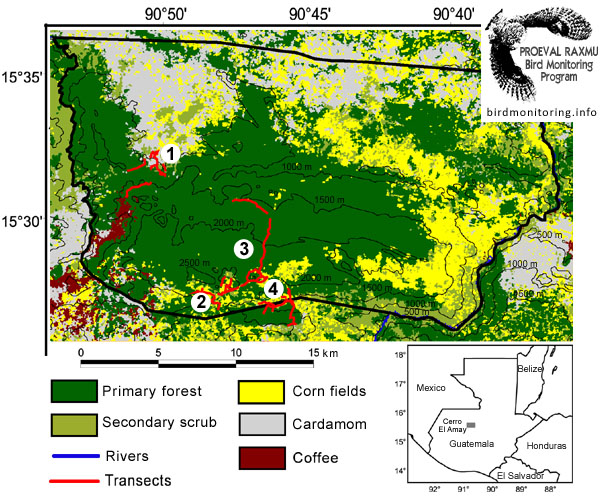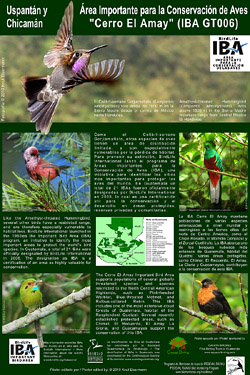Assessment of the avifauna of the Cerro El Amay Important Bird Area (IBA GT006)

Paper on the birds of IBA Cerro El Amay in journal COTINGA
Results of the bird survey at Cerro El Amay, including efforts on the search of Horned Guan (Oreophasis derbianus), have been published in Cotinga:
Eisermann, K., C. Avendaño & P. Tanimoto (2013). Birds of the Cerro El Amay Important Bird Area, Quiché, Guatemala. Cotinga 35: 81-93.
Abstract of the technical report
Knut Eisermann & Claudia Avendaño
September 2011
The Cerro El Amay Important Bird Area (IBA GT006), Quiché, Guatemala, covers an area of 453 km2. This is the first assessment of the avifauna of that IBA based on sampling in all altitudinal zones of the principal area of humid broadleaf forest at 1000 - 2600 m (3280 - 8530 ft). The survey was conducted on 30 days from October 2010 to April 2011. Audio-visual counts (diurnal and nocturnal intensive searches) were conducted along a total of
37.8 km of diurnal transects (n = 34 transects) and 21.4 km of nocturnal transects (n = 21 transects), in five different habitat types: humid broadleaf forest at 1800 - 2600 m (5900 - 8530 ft), humid broadleaf forest at 1000 - 1800 m (3280 - 5900 ft), forest edge and open area in both altitudinal zones, and pine forest at 1800 - 2200 m (5900 - 7220 ft). All birds seen and heard were recorded together with their perpendicular distance to the transect line (distance sampling). In addition, casual observations were recorded during 153 hours.
During standardized counts and casual observations, 265 species were recorded, of which 215 are considered residents. Another 47 species (18% of 265) were nearctic-neotropical migrants (39 winter residents and 8 transients). Another three species were summer residents, spending the northern winter in South America.
A total of 5662 birds was recorded during standardized counts. A rarefaction analysis showed that species richness was higher in broadleaf forest at 1000 - 1800 m compared to forest at 1800 - 2600 m. Applying a first order Jackknife estimator of species richness to the count data from transects (truncated at 40 m distance), species richness in broadleaf forest at 1800 - 2600 m was estimated to 130 ± 10 (SD) species, and at 1000 - 1800 m 196 ± 11 species. More than 320 bird species can be expected for the entire IBA, ranging in altitude from 300 to 2600 m.
In humid broadleaf forest at 1800 - 2600 m, most abundant species were Common Bush-Tanager, Gray-breasted Wood-Wren, Paltry Tyrannulet, Wilson's Warbler, Black Thrush, Yellowish Flycatcher, Amethyst-throated Hummingbird, Garnet-throated Hummingbird, Ruddy-capped Nightingale-Thrush, Mountain Thrush, Slate-throated Redstart, Golden-browed Warbler, Tufted Flycatcher, Rufous-browed Wren, Wine-throated Hummingbird, Brown-backed Solitaire, and Slate-colored Solitaire, and in broadleaf forest at 1000 - 1800 m Wilson's Warbler, Common Bush-Tanager, Yellowish Flycatcher, Golden-crowned Warbler, White-breasted Wood-Wren, Slate-throated Redstart, Green-throated Mountain-gem, Black-throated Green Warbler, Tawny-throated Leaftosser, Swainson's Thrush, Slate-colored Solitaire, and Gray-breasted Wood-Wren. Based on distance sampling data, population density of the most abundant species, Common Bush-Tanager, was estimated to be 6.5 birds/ha (95% confidence interval: 4.1-10.3) in broadleaf forest at 1800 - 2600 m, and 4.3 (95% confidence interval 2.8-6.5) in broadleaf forest at 1000-1800 m.
Most abundant migratory species, with a mean of at least 1 bird/1 km of transect in one of the sampled habitats, were Wilson's Warbler, Black-throated Green Warbler, Swainson's Thrush, Tennessee Warbler, Wood Thrush, Summer Tanager, Blackburnian Warbler, Gray Catbird, Rose-breasted Grosbeak, Blue-headed Vireo, Townsend's Warbler, Black-and-white Warbler, Least Flycatcher, Baltimore Oriole, Lincoln's Sparrow, McGillivray's Warbler, and Canada Warbler. Encounter rate of Wilson's, Black-throated Green, and Tennessee Warbler was in April similar among both types of broadleaf forest (1000 - 1800 m, 1800 - 2600 m) and forest edge and open areas at 1000 - 1800 m (Kruskal-Wallis test: Wilson's Warbler: H = 0.36, p = 0.8; Black-throated Green Warbler: H = 3.86, p = 0.1; Tennessee Warbler: H = 5.88, p = 0.05). Encounter rate of Swainson's Thrush was lower in forest at 1800 - 2600 m than in forest and forest edge and open area at 1000 - 1800 m (Kruskal-Wallis test: H = 7.28, p < 0.05).
In April, population density of Wilson's Warbler, the overall most abundant migrant, was 3.7 birds/ha (95% confidence interval: 2.2-6.2 birds/ha) in broadleaf forest at 1800 - 2600 m, and 4.4 birds/ha (95% confidence interval: 2.9-6.7) in forest at 1000 - 1800 m. Assuming a homogenous density throughout the forest, absolute abundance in 6100 ha of forest at 1800 - 2600 m and in 10400 ha of forest at 1000 - 1800 m was estimated to be 45760 birds (95% confidence interval: 30160-69680 birds). Based on the global population estimate of 36 Millions (Rich et al. 2004), broad leaf forest at 1000 - 2600 m supports 0.1%-0.3% of the world population.
With the new data from this bird survey, Cerro El Amay becomes the IBA with the highest number of species of conservation concern in Guatemala after the Atitlán Important Bird Area (IBA GT015). Cerro El Amay has still about 250 km2 of broadleaf forest, which is threatened by an advancing agricultural border. There is no strictly protected area of IUCN categories I or II within the IBA. There is an urgent need for conservation work in the farmer communities around the forested areas.
This survey was funded under NMBCA agreement GT-N51.
